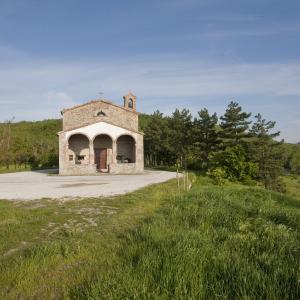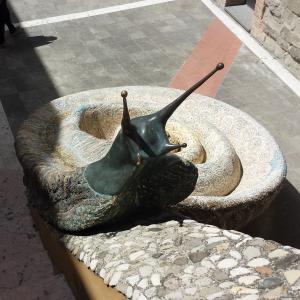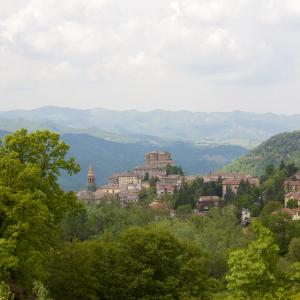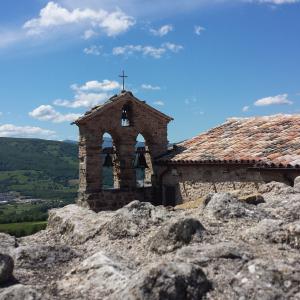11 things not to miss in Sant'Agata Feltria
Sant'Agata Feltria offers one of the most characteristic views of Montefeltro. The town lies between the valleys of the Savio and Marecchia rivers and has maintained a fairy-tale aura and appearance over time, with several complexes of considerable historical value to visit in every season.
Once in Sant'Agata, there are many things to see. Let yourself be captivated by the magic.
Fregoso Fortress
Now a museum, the fortress was built around the year 1000 but underwent radical transformation in the 15th century under Federico da Montefeltro, who entrusted the work to Francesco di Giorgio Martini. His architectural intervention transformed the military bulwark into a noble residence for Federico’s daughter, Gentile Feltria, who was given in marriage to the nobleman Agostino Giovanni Fregoso. On their arrival in 1506 the fortress was extended with the addition of new buildings and works of art, such as beautiful coffered ceilings on the first floor, monumental Renaissance fireplaces and a hexagonal chapel with 16th-century frescoes.
Collegiate church
Built in the 10th century and extended in 1520 by theFregoso, it has a 7th-century crypt. The side chapels are adorned with precious 17th and 18th-century inlaid and gilded ancones with many excellent pieces including a 16th-century wooden Crucifix of the German school and an altarpiece with Madonna and Child with St. Anthony of Padua by Giovan Francesco Nagli, known as Il Centino (1650).
Mariani Theatre
It is now a museum dedicated to the director of the band of Sant’Agata, a friend of Giuseppe Verdi. One of the oldest in Italy, it is made entirely of wood with three orders of boxes adorned with decorations and images of illustrious figures. Its narrow cavea and ellipses and the small stage give spectators the intimate feeling of being in a court theatre. Its simple lines are balanced by arches that crown the entrance and canopy, which is on the front of the façade and acts as a municipal tower.
Monastery and church of San Girolamo
The stone used to build it creates a chromatic balance with warm tones and an elegant cloister completes the innermost part. The church, formerly Our Lady of Graces, was dedicated to St. Jerome in the early 17th century when the Fregoso commissioned the magnificent Altarpiece of the Saint from the school of Pietro Berrettini da Cortona; it portrays the Madonna with Child and Saints Jerome, Christina, Francis and Anthony of Padua (circa 1640). The complex is now the St. Jerome Museum of Rural Arts. It has two sections; sacred art with furnishings and ornaments from the church and monastery and rural art that has social and educational objectives. As well as a display of old local handicrafts, there is a workshop where it is possible to study old trades.
Convent of the Poor Clares
Dating from the 16th century, it houses a collection of parchments dating from the 12th - 14th centuries. It appears to have been created by St. Clare’s sister who founded the order immediately after the order of St. Domenic, where Clare had taken up residence. From the same period, the adjacent church has undergone renovation work. It has rooms for overnight stays with the use of a kitchen.
Monastery of the Capuchins and Sanctuary
Commissioned by the Fregoso in 1575, the church has a painting of the Immaculate Virgin Mary, whose numerous miracles over the centuries have been studied with the authorization of the Sacred Congregation of Rites in Rome. Her image is venerated to this day by the faithful. The monastery now often hosts groups.
Sanctuary of the Madonna di Soccorso
Always supported by the local community, the church has the date 1609 on the entrance portal. Inside it has a beautiful gilded ancon portraying the miracleof Our Lady of Succour snatching a child from the devil. Our Lady of Succour has been venerated since ancient times by locals and several miracles have been attributed to her.
Snail Fountain
This fountain, designed by Tonino Guerra and part of his itinerary The Places of the Soul, is a poetic ode to slowness and the needs of the soul.
Petrella Guidi
Don’t miss this enchanting village that has retained its original aspect. The stone houses lining the narrow cobbled streets are overshadowed by the tower, testimony to its indomitable and powerful former role. The castle gate has symbols of power sculpted on it, like the coats of arms of the Malatesta and the Church. Its origins are distant; in fact traces of Roman ruins have been found here. At the foot of the tower there is a tribute to local poet Tonino Guerra and film director Federico Fellini and his wife, Giulietta Masina.
In Petrella Guidi it is also possible to enter a true work of art thanks to the Renaissance Views, a balcony overlooking the same landscapes painted by Piero della Francesca in some of his most famous works. It is here that we can see the landscape of the 'Baptism of Christ', a work that is now in the National Gallery in London.
To See the Stars Again
An itinerary to reflect on the story of Jesus, with a reconstruction of some of the most representative Evangelical scenes, designed to highlight their poignant relevance. Pieces by Italian and foreign artists are presented, creating an unusual diffused museum with stops at abandoned or disused sacred sites usually not included in standard itineraries.
Truffle Ecomuseum
It is a unique facility in Emilia-Romagna; it is devoted to the white truffle and its relationship with the environment in which it grows.
The 'tuber magnatum pico' is the symbol of the village and is the focal point of a fair - scheduled for Sundays in October – well-known throughout Italy.
Taken from Malatesta [&] Montefeltro: a journey through the hills of Rimini



